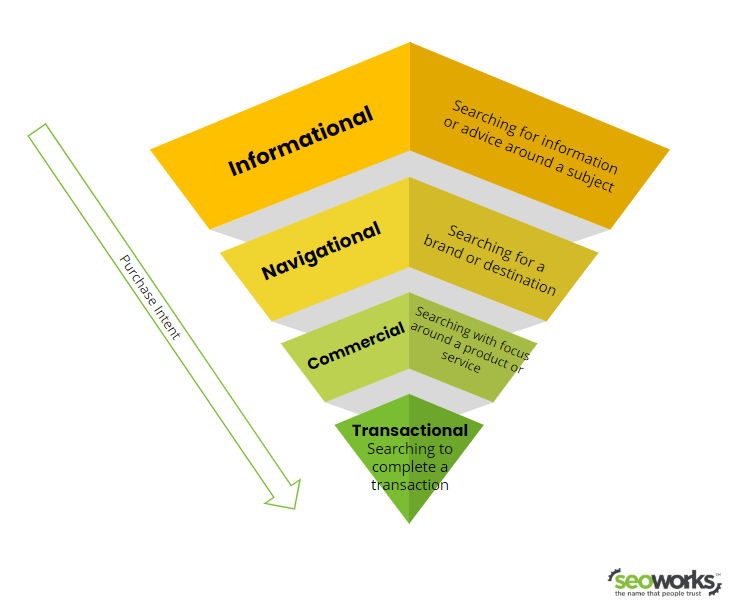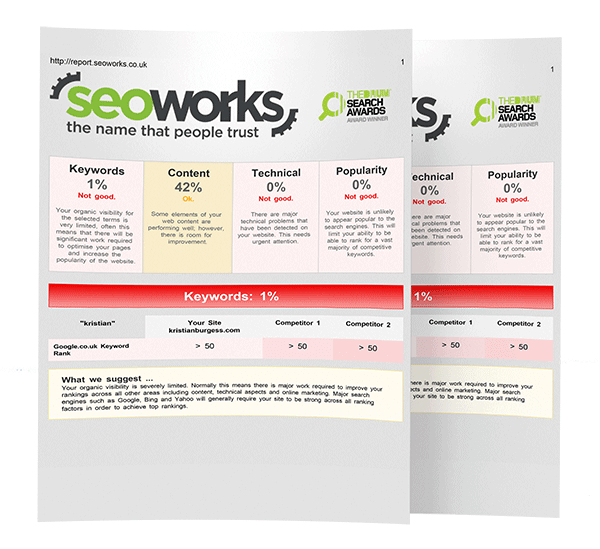The Complete Guide to Search Intent for SEO
Search intent is often one of the most overlooked ranking factors but arguably one of the most important. Have you ever had a page that seemingly has super useful content and is optimised for keywords, yet you still aren’t ranking?
The most likely culprit is search intent.
Our complete guide will teach you what search intent is, what the different types are, why it matters for SEO and most importantly, how to optimise for it.
What is Search Intent?
Search intent, also sometimes known as user intent, refers to the meaning behind a search query; what is it the user is actually looking for by searching for that specific term?
It is essentially the goal of the user and could fall into a range of categories including informational, navigational, commercial or transactional. We will look at these in more detail a little later.

Search intent can often be inferred from the types of words used within search queries, for example if a search contains the word ‘how’, it is likely they are looking for information, or if the query contains the word ‘buy’, it is likely they are looking to make a purchase. By aligning your content to the users intent you can help to improve your rankings, and provide a relevant solution to the users query.
What are the Different Types of Search Intent?
Briefly mentioned above, there are 4 main types of search intent. These are informational, navigational, transactional and commercial. Learn more about each of the different types below.
Informational Queries: In informational searches the user is simply looking for information on a certain topic. Often formulated in a question style e.g. ‘how do I get more traffic online?’, ‘What is the best way to get traffic online?’, these are usually relatively easy to spot however, there are some exceptions. Informational queries may also be presented in a non-question format e.g. ‘search intent guide’.

Navigational Queries: Navigational queries are those of people who already know where they want to go. It may just be a case of it’s easier to search for a specific website then it is to type in the URL. They may also be looking for a specific section of the website such as the blog. An example of a navigational search would be ‘SEO Works’ or ‘SEO Works blog’. It is hard to capitalise on these if the search is not directed at your website as the user already has a clear idea of where they want to end up.

Commercial Queries: Commercial, or commercial investigation, searches help the user to make a decision on the best solution to their query. Linked to informational, this style of search often compares products or services to provide users with more detailed information that will eventually allow them to decide on the best solution for them. Searches may also take the form of reviews or lists. Some examples of searches with a commercial intent include ‘best SEO companies’, ‘SEO Works review’ or ‘SEO vs PPC’.

Transactional Queries: Transactional searches occur when the user is nearing the end of the buying cycle and is looking to make a purchase. This type of search will often contain language cues such as the terms ‘buy’, ‘buy online’ or ‘cheap…’. Anything related to price, buying or where to buy will generally be a transactional search. E.g. ‘online SEO services’.

Why is Search Intent Important for SEO?
With search engine algorithms improving by the day, keyword mentions are simply not enough anymore. Search engines are now able to determine the searchers intent much better than they used to. They then display content most relevant to that intent. Aligning your pages to this is therefore essential in order to gain high rankings. In doing this, your impressions will increase which in turn will help to boost traffic to your site.
In addition to this, by accurately communicating the intent of your page to users via the page title and meta description, you can also help to increase click through rate. Well-optimised meta will help to convince users that they will find the solution to their query on your page and will therefore encourage them to click through.
In relation to this, by attracting the right type of users to your site, they are more likely to convert. This is because if your page matches their search intent, you are presumably able to provide a solution for them. This is true of all types of searches, even informational. If they navigate to your site and see you as a useful source of information, users will be more likely to use you in the future for products or services as they will trust you.
The Importance of Search Intent Summary
- Higher impressions
- Boosts traffic
- Increased click through rate
- Higher chance of conversion
- Improved trust
How to Optimise for Search Intent?
So now you know why optimising for search intent is important, you may be wondering how do you actually do it?

SERP Analysis
The first step is analysis. This is key; if you don’t determine the type of search intent before starting, it’s more likely that your page won’t match up. In order to determine the user’s goal, look at the search engine results pages. The search query itself may hold some clues. Look at the language used; are they trying to buy something, or are they asking a question? Once you have looked at this, review the top results. How is their page formatted? What kind of information is included?
Further clues to the search intent may also be inferred from certain SERP features. For example, if ‘people also ask’ boxes appear the search is more likely to be informational, if a product carousel is present, the search is likely transactional. This is not a foolproof method however, so make sure to carry out detailed analysis of all the top search results.
You should also note, that search intent is not necessarily black and white…just to make it that little bit harder. Search intent can be mixed, e.g. ‘Things to know before hiring an SEO agency’. This search is predominantly informational but, it also has a transactional element to it as the user is looking to buy services.
Aligning your Content to the Intent
You should have learned a number of things from your SERP analysis, including what type of content is ranking highly e.g. blogs, landing pages etc., it’s style e.g. video, infographic, text etc. how it is formatted e.g. a guide, a review etc. and what angle it takes. Once you have determined these things, you should have a solid plan for how you can adjust your page to match the search intent of the user.
If ‘how to’ guides are ranking highly, write your own and try to offer more useful information than that of the top search result. You should also adjust your meta to better communicate the content of the page to users. As previously mentioned, this can help to improve your site’s click through rate and attract traffic that is more likely to convert.
Review Regularly
It is important to note that search intent is not static. It can fluctuate and change over time so if you notice any rapid keyword drops, your first port of call should be to check the search intent of the target query, and repeat the above steps if necessary.
Search intent – in summary
Understanding and analysing search intent will influence your content creation, and ultimately help you answer the questions your target market are looking for, resulting in a better chance of search visibility.
Still not sure or too busy to ensure your search intent is on-point? Get in touch with a member of the SEO Works team. Our SEO campaigns are tailored to your business’s needs to generate more traffic to your website! Contact us on 0800 292 2410 or via our form.


